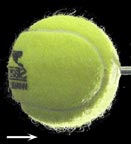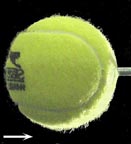October 2001 Article Tennis Server
|

 |
The Aerodynamics of Tennis Balls
With the approval of the three ball types by the International Tennis Federation (ITF) at the Annual Group Meeting (AGM) in Cancun, Mexico in mid-September, I thought we might examine some specific tennis ball aerodynamics research. The new rules are already on the ITF site. The bottom line: a tournament's surface may determine which of three ball types are used: Type 1 (fast speed), Type 2 (medium speed) and Type 3 (slow speed). Although you've probably read and understand how ball size changes the velocity and forces on a tennis ball, you may not be aware the fabric cover itself affects ball speed and flight path. That's right - take the same size ball, wear the ball cover or fluff up the fabric and you'll get a different amount of air resistance (aerodynamic drag) on the ball. Ever watch the pro's examine and toss back tennis balls before the serve (especially the first serve)? Even John McEnroe commented during this year's US Open: one thing they are looking at is the condition of the ball's fabric. The forces on a tennis ball interact like a game of a tug-of-war. The combined strength and direction of each of the forces on a tennis ball (weight, lift and drag) determine the curved flight path of the tennis ball (the trajectory). Change one of these forces and you change the trajectory of the ball.
As a matter of fact it appears the very first observations on sports ball aerodynamics were related to tennis and made by Sir Isaac Newton himself when he wrote in 1672: "I remembered that I had often seen a tennis ball I describe such a curveline. For, a circular as well as a progressive motion being communicated to it by that stroke, its part on that side, where the motions conspire, must press and beat the contiguous air more violently than on the other, and there excite a reluctancy and reaction of the air proportionably greater." Over two hundred years later, Lord Rayleigh wrote the paper: "On the Irregular Flight of a Tennis Ball," and said "A rapidly rotating ball moving through the air will often deviate considerably from the vertical plane." What did they say? Spin effects the flight path of a tennis ball. But you knew that (wink)! How important is it for you to understand the forces on a tennis ball? Clearly at the player's level experience, expertise and technique on the court is more important in successful ball placement. Within the industry and for those charged by the governing sports body to oversee equipment innovation, there is a need to understand how technological advancements affect the game. In support of this, the ITF commissioned the design and construction of a wind tunnel specifically to study tennis ball aerodynamics. As the concept of the larger ball was introduced, several research efforts examined the aerodynamic forces on tennis balls using wind tunnels. Wind tunnels are chambers where air is blown over an object to determine the forces on its body. (In the 1800's researchers recognized it did not matter if an object flew threw the air or if an object was stationary and the same speed air blown over the object. The aerodynamic forces would be the same in both cases.) Among the teams were Dr. Steve Haake from the University of Sheffield (working directly with the ITF); Dr. Alison Cooke, then the Director of the Sports Engineering at Cambridge University; and myself and Dr. Rabi Mehta from the NASA Ames Research Center in California. Rabi and I conducted a series of experiments as part of a larger educational project using tennis to introduce pre-college students to aerodynamics.
There were questions to answer. As previously mentioned, sports ball aerodynamics is not a new subject. Research published on the aerodynamic characteristics of other sports balls like golf, cricket and baseball suggested increasing the ball's diameter could actually increase the ball speed. Of course the implication of this was that the Rusedski's of the world would be given even a greater advantage. Additionally, Haake's group investigated the drag on raised (fluffed up) and worn balls which was repeated by the NASA/Cislunar study. As you would imagine, fluffed up ball's had higher drag coefficients than worn fabric or low fuzz balls. But what the groups were looking for were specific ranges of lift and drag. Why? The mathematical equations for the forces, acceleration, velocity and position of a tennis ball are all related to one another. Although most of those variables in the equations like air density and ball diameter can be easily determined, the lift and drag parameters are determined through experimental tests (typically using wind tunnels). So the researchers wanted to have these numerical values so that they could predict ball behavior in the future. Unfortunately, this isn't just one number. These lift and drag parameters vary with ball speed and spin rate. In some sports, like baseball, lift and drag even vary with the position of the ball's seams. As the researchers all found out, on the tennis ball, the aerodynamic forces change with the type of felt and its condition. We'll save lift, weight and looking at all the forces together for another day and another column and just focus on air resistance (drag). Drag is the impeding force, which slows on object down. There are different causes of drag and subsequently scientists and engineers have a different name for each of them.
The tennis ball cover is rough but not like sandpaper. Looking closely at the felt you can see that air flows through those raised fabric filaments - better known as fuzz. So the surface of a tennis ball is a "porous surface." It's more like dealing with the wind blowing through leaves on a tree and just as complicated. The fuzz filaments act like tiny cylinders each having their own drag component. In addition to the skin friction drag from the cover itself, drag is created from the airflow over these fuzz fibers interacting with all the other fibers behind it. Rabi Mehta dubbed this phenomenon "fuzz drag." Experiments Mehta conducted also showed that as the ball speed increases the fuzz filaments lay down on the ball and the fuzz drag declines. Here are two pictures from the wind tunnel test. You can see in the picture on the right that the fuzz is closer to the ball's surface. The air passing over the ball on the left is about 45 mph, while on the ball on the right the air is 135 mph.
The implications are clear - it's not just the size of the ball. The fabric cover changes during a match affect the aerodynamics and flight of the ball - an important consideration in future ball design and technology. I've included references in the column for those interested in more information. Two of the best sources for this material are Tennis Science and Technology (Haake, S.J. and Coe, A., eds.) which was the Proceedings of the 1st International Conference on Tennis Science and Technology held last year in London as well as the Sports Engineering journal. Until next month ... Jani
Photos and graphics courtesy Cislunar Aerospace, Inc. and NASA.
References:
Chadwick, S.G. and Haake, S.J. (2000b) Methods to determine the aerodynamic forces acting on tennis balls in flight. Tennis Science and Technology (Haake, S.J. and Coe, A., eds.) Proceedings of the 1st International Conference on Tennis Science and Technology. Blackwell Science, Oxford, UK, pp.127-134. Mehta, R.D. and Pallis, J.M. (2001), Sports ball aerodynamics: effects of velocity, spin and surface roughness. Paper presented at the Materials and Science in Sports Conference, Coronado, California, April 22-25, 2001. Mehta, R.D. and Pallis, J.M. (2001), The Aerodynamics of a Tennis Ball. Sports Engineering, 4, 1-13. Newton, I. (1672), New theory of light and colours. Philosophical Transactions of the Royal Society London, 1, 678-688. Rayleigh, Lord (1877), On the irregular flight of a tennis ball. Messenger of Mathematics, 7, 14-16.
This column is copyrighted by Jani Macari Pallis, Ph.D., all rights
reserved.
Dr. Jani Macari Pallis is the founder and CEO of Cislunar Aerospace,
Inc., an engineering and research firm in San Francisco. In addition
to her engineering practice, she has led two collaborations between
NASA and Cislunar, creating educational materials on the aerodynamics
of sports for pre-college students and educators. As the head of
NASA's "Aerodynamics in Sports" project, she has led a team of
researchers investigating the aerodynamics, physics and biomechanics
of tennis. The group has conducted high speed video data capture at
the US Open and research of ball/court interaction, footwork, serve
speeds, trajectories and ball aerodynamics. Pallis received a BS and
MS from the Georgia Institute of Technology, an MS in mechanical
engineering from the University of California, Berkeley and a Ph.D.
in mechanical and aeronautical engineering from the University of
California, Davis. She is a member of the Executive Committee of The
International Sports Engineering Association.
Questions and comments about these columns can be directed to Jani by
using this form.
|



October 2022 Tennis Anyone: Patterns in Doubles by John Mills. September 2022 Tennis Anyone: Short Court by John Mills. |
 You will join 13,000 other subscribers in receiving news of updates to the Tennis Server along with monthly tennis tips from tennis pro Tom Veneziano.
You will join 13,000 other subscribers in receiving news of updates to the Tennis Server along with monthly tennis tips from tennis pro Tom Veneziano. 




